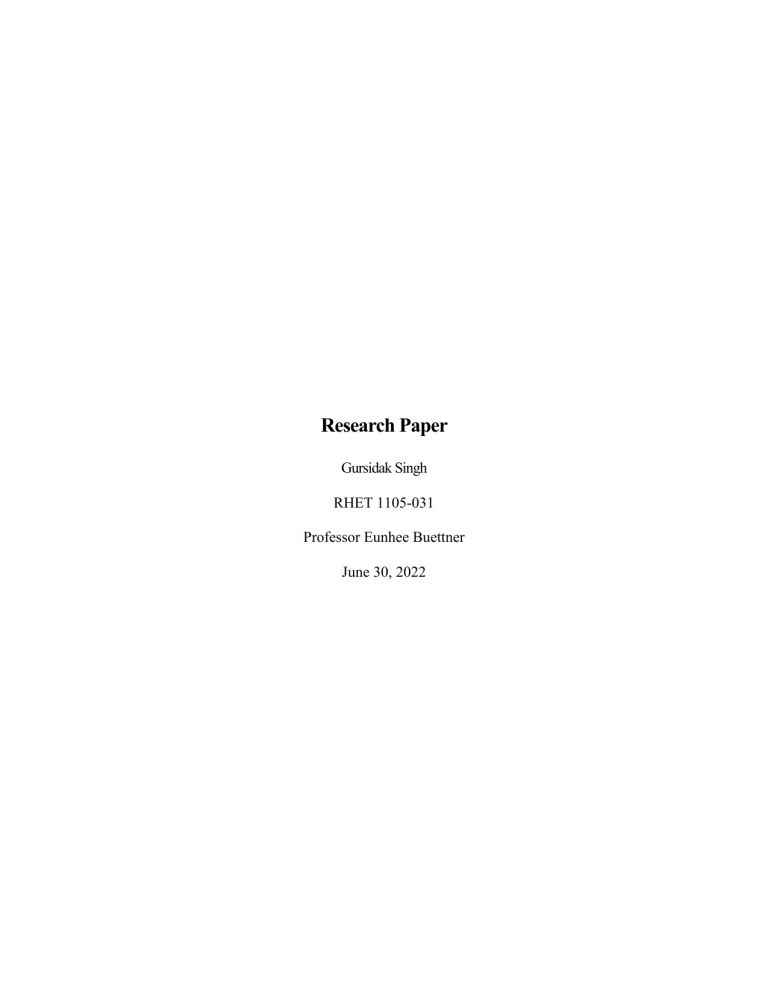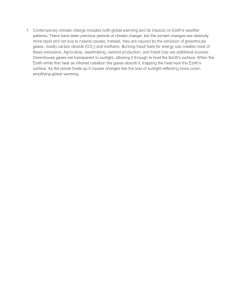
Research Paper Gursidak Singh RHET 1105-031 Professor Eunhee Buettner June 30, 2022 In this world, we have gas, war, economic, and social problems; we have cold wars, racism, diseases, and life-threatening viruses, with all these problems. However, one major problem that most of us do not take seriously is Climate change. We all see social media posts and different campaigns and make posters of the earth crying and burning of the cruel actions of humankind. Nonetheless, do we know what climate change and problems like global warming are? Are we familiar with the basics of what climate is? Moreover, how does our earth work in general? While answering all these potent questions. This research will show the causes and effects of climate change. What actions can we take to slow this change? What is the history of climate change? Lastly, what mindsets we can adopt to deal with these problems that can help change our society for good. Before we move onto what climate change is, it is important to know the basics of climate and workings of our nature. Firstly, what is weather, weather is the state of atmosphere with respect to heat or cold, wetness or dryness, calm or storm, clearness or cloudiness (Merriam-Webster, 2022). Weather is volatile and can change from hour to hour, day to day, and month-to-month in some cases even year to year. A season is division of changes in weather, there are 4 seasons spring, summer, fall (autumn) and winter. Climate on the other hand, is the long-term pattern of weather in a particular area. Climate Change (Overview and History) Climate change is the sudden rise in hot temperatures and unpredictable weather with long summers and winters. Climate change is the increasing variability in the measure of climate over a long period, including temperatures, precipitation and wind patterns i.e. weather. The natural working of our environment is that our earth emits infrared radiations and release them onto space. As we know, that sun is very hot, and if we start to get all the radiations from the sun than we will die because our bodies would not be able to cope with the excess heat (radiations). Earth only takes the amount of energy from sun that is sustainable for our environment; rest it releases back to space; this is also called the natural energy balance. However, burning of fossil fuels and excess uses of gasoline vehicles produce greenhouse gases these gases trap the radiations while moving out and redirect them back to the earth; causing excess heat, which further raises the temperature of environment. As the planet heats up, it causes the loss of sunlight-reflecting snow cover, further amplifying global warming. Most common greenhouse gases are carbondioxide, methane, nitrous oxide and methane. Greenhouse gases are naturally and are part of our atmosphere's recipe, these gases help earth loose excess heat more efficiently; this process is also known as greenhouse effect. Our earth’s conditions neither too hot nor too cold, but just the right balance to allow life to flourish. This greenhouse effect is What makes Earth so adaptable it keeps the planet at a friendly 15 °C (59 °F) on average. But in the past few decades we have been interfering with the planet's energy balance, through the burning of fossil fuels which adds carbon dioxide in the air. The level of carbon dioxide in Earth’s atmosphere has been rising consistently which again plays a role in trapping extra heat near Earth's surface, causing temperatures to rise. Climate change is the increasing changes in the measure of climate. Whereas, Global warming is the rise in the global temperatures due to greenhouse gases. There causes and effects are similar that is why climate change and global warming are usually confused with each other. Climate trends over the past can be analysed through surface-based instrumental records. Temperature changes in the early part of last century maybe due to the natural variations, but the warming seen in the last 50 years is difficult to explain unless one includes the effects of increasing greenhouse gases. Consequences As the planet heats, it causes higher temperatures. These higher temperatures cause heat waves, which then cause forest fires and other disasters like droughts, cyclones, and ice melting. This melting of ice in the arctic; removes the snow cover, which helps reflect the sunlight. This melting changes the sea's chemical composition, making it hard for the species living in the sea to survive. Moreover, there is an increase in deserts; changes in the mountains and coral reefs cause many species, even some human tribes, to either vanish or relocate. This relocation can cause social conflicts, creating even more problems. The trees in the tropical forests, like all green plants, help absorb all the carbon dioxide from the atmosphere and then release oxygen which is called photosynthesis. Plants carry opposite respiration processes to make their food by converting sugar and glucose for energy. When forests grow, photosynthesis usually exceeds respiration. Trees store the excess carbon in their trunk, roots and soil; this process is called sequestration. So, when deforestation happens, much of that stored carbon is re-released into the atmosphere as CO2. Moreover, this is how deforestation contributes to climate change. Furthermore, climate change can cause droughts and degradation of seas, as the increase in sea temperatures give rise to the sea level. Which then causes food and water scarcity and increases flooding. Lastly, this extreme heat will cause more diseases and economic loss as extreme weather can cause heavy damage to infrastructure and property. Solutions Humankind has always dealt with the most demanding challenges: a pandemic outbreak, an economic recession, or a natural calamity. Our human strength is in our ability to get together and fight for the good of our future. We do not want our next generation to suffer even more than we already are. So, the first thing we can all do is to start planting more and more trees. We know that nature is vital in regulating the climate by storing carbon dioxide. By conserving forests and wetlands while using nature-positive practices in agriculture, we will be able to utilize nature's full capability to neutralize climate change. The best solution so far is to practice and implement Regenerative Food Systems. In Regenerative food systems, we grow food in a nature-friendly way, for example- using cover crops between harvests or planting crops without tilling the soil. This practice will help restore the complex soil biology. Right now, our practices are harming nature and affecting our ability to grow more food for the future. Implementing strategies like the Regenerative food system will reduce greenhouse gas emissions and even water pollution. Aquaculture is a game-changer when it comes to filtering the seawater. For example, oysters get their nutrients while filtering the water, whereas seaweeds store carbon without leaving the seabed (Conservancy, 2021). Indigenous people use the regenerative food practice to this day. Furthermore, these methods will help keep up with the increase in food production demand, increase biodiversity, protect our water and help strengthen our economy in the long-term. Moreover, pressuring the government to promote clean energy policies, clean hydrogen production and finding ways to store carbon permanently. Governments can promote these practices by introducing tax credits and attractive incentives for small businesses or companies who decide to switch to renewable production and energy. In addition, limiting the use of gasoline vehicles and opting for electric or hybrid vehicles would help. Lastly, educating more people about the problem by educating children and introducing more campaigns on a larger scale will generate even more awareness. In conclusion, we have to take shared responsibility for our actions, and every one of us should try our best to implement the solution to conserve our beautiful nature for future generations. Just like every drop of water can create an ocean, in the same way, small and meaningful steps taken in the right direction can result in significant changes. Our day-to-day world problems will not even matter if there is no world in the first place. On a positive note, people are now getting more aware of the problem. The governments and big organizations like the United Nations are taking significant steps toward implementing policies to help lower carbon emissions. With the oil prices rising drastically, people are already switching to hybrid and electric vehicles. In the upcoming years, more and more solutions will come, and in the same way, as we always have, we will come out of this problem. Bibliography Regenerative Food Systems. (2021). The Nature Conservancy. https://www.nature.org/enus/what-we-do/our-priorities/provide-food-and-water-sustainably/food-and-waterstories/regenerative-food-systems/?vu=foodsystems Solving Climate Change with Smart Policy. (2020, April 6). The Nature Conservancy. https://www.nature.org/en-us/about-us/who-we-are/how-we-work/policy/smart-climatepolicy/ Cho, R. (2019, June 20). How Climate Change Impacts the Economy. State of the Planet; Columbia Climate School. https://news.climate.columbia.edu/2019/06/20/climatechange-economy-impacts/ US EPA. (2018, November 6). Climate Change Indicators: Oceans | US EPA. US EPA. https://www.epa.gov/climate-indicators/oceans Union of Concerned Scientists. (2021, November 10). Tropical Deforestation and Global Warming. Union of Concerned Scientists. https://www.ucsusa.org/resources/tropicaldeforestation-and-global-warming Ridgwell, A., & J. Valdes, P. (2009). Climate and climate change. Current Biology, 19(14). https://doi.org/https://doi.org/10.1016/j.cub.2009.05.014 Government of Canada. (2019, March 28). Causes of climate change. Canada.ca. https://www.canada.ca/en/environment-climate-change/services/climatechange/causes.html






